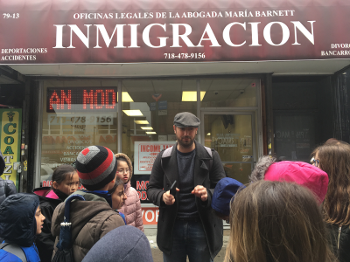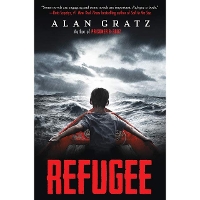Elementary Book Club Tackles Immigration; Takes Walking Tour To Explore Cultures and Food
A New Jersey school book club read titles connected to an immigration and refugee theme then took a walking tour of a New York City neighborhood to help bring the text to life.
Rick Darst’s first attempt at an outside-of-class book club did not go well. There were too many kids and only him to guide them during the lunchtime discussion. It was more than a decade ago, and at a different school, but the failure kept him from trying again since.
Then last year at a literacy workshop, the fifth-grade teacher was speaking with colleagues from another school in the Livingston, NJ, district where he works and heard about their lunch book club. It was kept small by asking kids to apply to be included, and there was a field trip connected to the theme.
“Ours is kind of a riff off of theirs,” says Darst, who immediately began planning with Mt. Pleasant Elementary’s library media specialist Lenore Piccoli. She has also spent years wanting to start a book club but never finding colleagues who could make it work in their schedules.
 The two took the same theme as their district colleagues: “Books that had to do with people immigrating, moving, being forced out of their home,” says Darst.
The two took the same theme as their district colleagues: “Books that had to do with people immigrating, moving, being forced out of their home,” says Darst.
“One of the main reasons we chose it was because it was a big topic in the news—immigration, refugees,” he says. “The other reason—and when I say this, I’m not putting any judgment on it, it’s just a fact—our kids kind of live in a bubble. So they’re not always aware that there are people out there who live different lives than they do; that there are people who struggle in other ways than they might struggle. That’s important, I think. It’s why we should be reading, to get outside of our own world, out from under our dome. We all live under a dome of one kind or another. Reading is an experience. You get to experience another way of living.”
Darst and Piccoli took the theme. They changed the books—and the field trip.
 They chose Esperanza Rising by Pam Muñoz Ryan, Shooting Kabul N. H. Senzai, and Refugee by Alan Gratz.
They chose Esperanza Rising by Pam Muñoz Ryan, Shooting Kabul N. H. Senzai, and Refugee by Alan Gratz.
“We wanted a girl main character and a boy main character then multi characters,” says Piccoli. “[Refugee] is a difficult book, but we had good readers and since we were discussing it with them, it became something that was very doable. There were three main characters. There was somebody they were going to love and root for then all the stories came together.”
Darst and Piccoli asked the school’s reading specialist Gianna Goeller and fourth grade teacher Jen Szostak to be part of the book club as well. The four educators coordinated their schedules to meet one day a week at lunch with 14 students.
“The four of us all had the same goal of getting kids to love books and reading,” says Szostak. “We also all really enjoyed learning from the kids as well as learning from each other—just watching another educator interact with students is a learning experience…sometimes as teachers, we don’t get to do that enough.”
They would spend half of the lunch period eating and chatting and the other half discussing the book.
“The teachers took a back seat once discussions started, and it was wonderful to see how involved the kids were and how excited they were to talk about their ideas,” she says.
At times, those discussions went in impressive and unexpected directions, says Darst, often with the adults having “eyebrow conversations” with one another as the students made observations about the book or connected something from the text with current events.
As a special bonus, each student received their own copy of each book, thanks to Piccoli, who says she is fortunate to have a good budget and used it to buy the books, which the kids could then take notes in.
“I’m the librarian that always tells them, ‘You’re not allowed to write in the books they don’t belong to you,’ but now this is just the opposite,” she says. She told them this was their personal book, “You can write all the notes and thoughts and feelings you have inside.”
As for the field trip, the other elementary school had gone to Ellis Island. Darst considered that or perhaps Manhattan's Lower East Side where new immigrants once congregated upon arriving in the United States but quickly realized those were not the people his students were reading about.
 Then he thought about his former neighborhood, Jackson Heights, in Queens. Incredibly diverse and home to recent immigrants, according to a 2015 documentary on the New York City neighborhood, there are more than 160 languages spoken among the approximately 170,000 people who live there. Darst did some research and found a walking tour that involved sampling the local food while learning about the architecture, culture, and history of the area. He spoke with the tour guide who agreed to create his first kids' version and crossed his fingers that the students would enjoy it.
Then he thought about his former neighborhood, Jackson Heights, in Queens. Incredibly diverse and home to recent immigrants, according to a 2015 documentary on the New York City neighborhood, there are more than 160 languages spoken among the approximately 170,000 people who live there. Darst did some research and found a walking tour that involved sampling the local food while learning about the architecture, culture, and history of the area. He spoke with the tour guide who agreed to create his first kids' version and crossed his fingers that the students would enjoy it.
“They loved it. I was worried, kids can be picky eaters, but they were very willing to try the food and see just exactly what life might be like for an immigrant,” says Darst, admitting there was some complaining as they sampled South Asian, South American, and more foods on the chilly, rainy day. “They were able to make connections between what they were seeing on the street and what we had read in the books, which I thought was important.”
His fellow teachers enjoyed it, too.
“It’s one of the top things I’ve ever done,” says Piccoli.
Darst particularly enjoyed an unexpected bonus when the Indian students in the book club happily contributed to the tour.
“We never even thought about the kids whose cultures we were going to view, how proud they were,” says Darst. “They were able to share their culture with kids in the book club who were Jewish and Italian kids from Livingston.”
Darst and Piccoli are now working on a theme and field trip for next year. With the help of his colleagues and the limited number of students, this time around his book club attempt was an undeniable success.
“There were a lot of moments when I thought, this is better than I ever even imagined,” he says.
RELATED
The job outlook in 2030: Librarians will be in demand
The job outlook in 2030: Librarians will be in demand
ALREADY A SUBSCRIBER? LOG IN
We are currently offering this content for free. Sign up now to activate your personal profile, where you can save articles for future viewing






Add Comment :-
Be the first reader to comment.
Comment Policy:
Comment should not be empty !!!